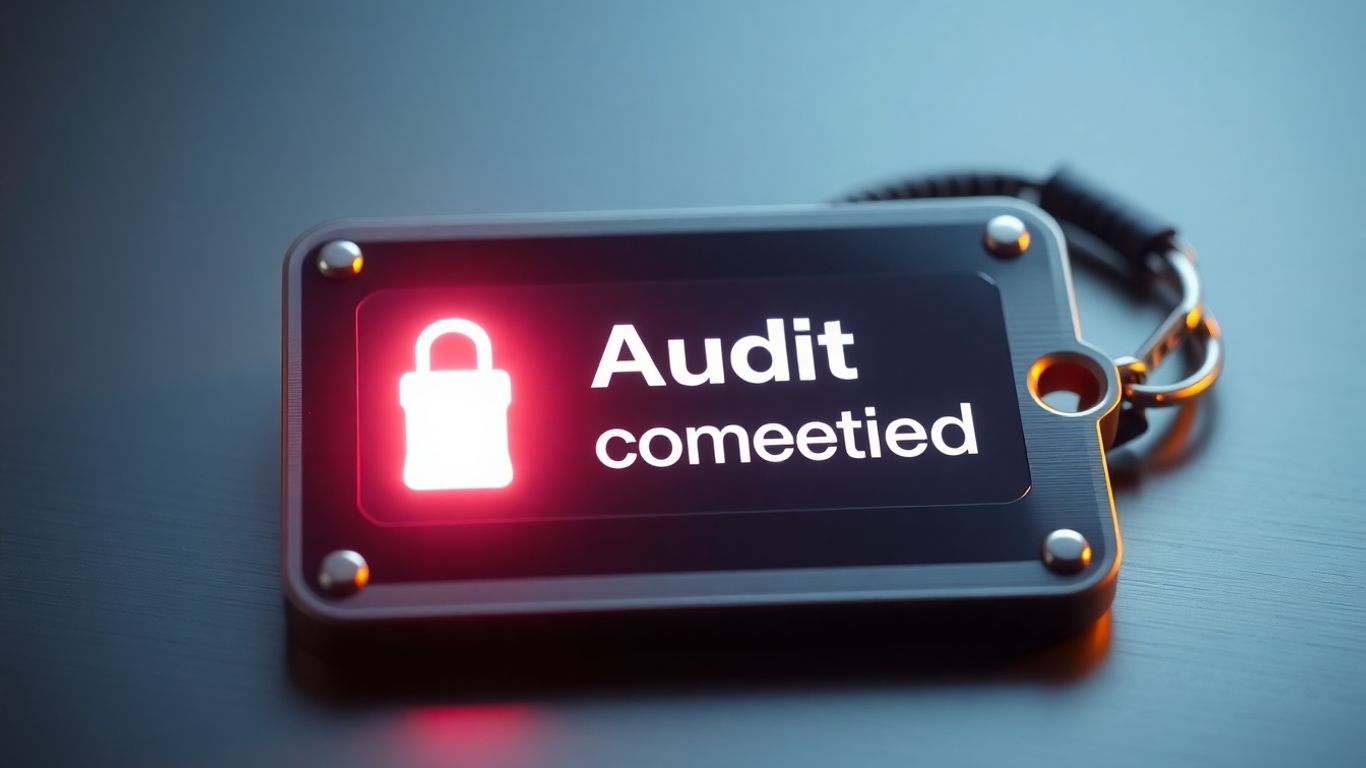[ newsletter ]
Stay ahead of Web3 threats—subscribe to our newsletter for the latest in blockchain security insights and updates.
Thank you! Your submission has been received!
Oops! Something went wrong. Please try again.
Enhance your platform with the Security Score Widget. Learn how to integrate, customize, and leverage it for increased trust and visibility.





So, you've heard about this thing called a security score widget, and you're wondering what it's all about. Basically, it's a tool that shows you how secure something is, like a website or a piece of code. Think of it like a quick check-up for digital safety. We're going to break down what these widgets do, how you can use them, and why they're becoming a big deal for building trust online. It's not as complicated as it sounds, promise.
A Security Score Widget is essentially a visual tool that gives you a quick snapshot of how secure something is. Think of it like a dashboard light for your digital assets or systems. It takes a bunch of complex security data and boils it down into an easy-to-understand score, usually on a scale of 0 to 100. The lower the number, the better the security. It's designed to make security information accessible without needing to be a cybersecurity expert. These widgets are becoming more common, especially in areas like Web3 development where understanding the risk associated with smart contracts or wallets is super important. For instance, platforms are starting to show Smart Contract Trust Scores to help users gauge project safety.
So, what actually goes into making up this score? It's not just one thing. Different widgets look at different aspects, but generally, you'll find a mix of these:
It's a bit like checking a car's safety features: you look at the airbags, the brakes, the structural integrity, and maybe even its accident history. All these pieces come together to give you an overall picture.
The goal is to translate intricate security assessments into a single, digestible metric. This helps bridge the gap between technical security details and the understanding of non-technical stakeholders, making security more transparent.
Adding a security score widget to your platform or documentation can really make a difference. For starters, it builds trust. When users or investors can see a clear, objective measure of security, they feel more confident interacting with your project or using your services. It also helps with risk management. By highlighting areas that might be weaker, it guides where security efforts should be focused. Plus, it simplifies communication. Instead of explaining complex security protocols, you can point to the score. This transparency can be a huge plus, especially in the fast-paced world of digital assets where recent incidents have led to significant losses.
Here are some key benefits:

Adding a security score widget to your platform isn't just about showing a number; it's about making complex security information easy to grasp. Think of it like a dashboard for your system's health. You can get real-time updates, customize how it looks, and even embed it right into your documentation. This makes security transparent for everyone involved.
To get the most out of a security score widget, you'll want to connect it directly to your security data sources. This usually means using an API. The API acts as a messenger, fetching the latest security information and sending it to the widget. This way, the score you see is always up-to-date, reflecting the current state of your security.
Here's a general idea of how it works:
This real-time connection is key for making informed decisions quickly.
Not all platforms look the same, and your security widget shouldn't stick out like a sore thumb. Most widget systems let you tweak how they look. You can often change colors to match your brand, adjust the size, and pick which specific security metrics are displayed. Some might even let you choose different visual styles, like a simple number, a progress bar, or a more detailed breakdown.
Here are some common customization options:
Documentation sites are a natural fit for security score widgets. When users are reading about your product or service, seeing a live security score builds trust. It shows you're transparent about your security posture. Embedding is usually straightforward, often involving copying and pasting a small piece of code (like an iframe or a JavaScript snippet) into your documentation's HTML.
For example, if you have a page detailing your API's security, embedding a widget there would provide immediate context. It's a simple way to add a layer of credibility without overwhelming the reader with technical details.
So, you've got this security score widget, and you're wondering how it actually helps build trust. It's not just about having a number; it's about what that number means to the people using your platform. Think of it like a credit score, but for digital assets or services. It gives users a quick way to gauge the safety and reliability of something before they commit their time or money.
When you're dealing with smart contracts, especially in the world of decentralized finance (DeFi) or tokenized assets, trust is a big deal. A smart contract trust score gives you a snapshot of how secure a particular contract is. It's not just a one-time check; these scores are often dynamic, meaning they change based on ongoing analysis. They look at things like the contract's code structure, how it handles operations (like managing funds or data), and even its past performance. This helps people decide if a project is worth engaging with, moving beyond just reading a static audit report. For instance, platforms like RWA.io use these scores to give investors a clearer picture of the risks involved.
Now, let's talk about wallets. In any blockchain ecosystem, wallets are the gateways to your assets. But not all wallets are created equal, and some can be linked to risky activities. Wallet trust scores help analyze the behavior associated with a specific wallet address. They look at transaction patterns, who else the wallet interacts with, and its overall on-chain history. This is super useful for spotting potential threats early on. Partners like Etherscan offer these scores, which can be a lifesaver when you're trying to figure out if a transaction or an address is legitimate. It’s about making sure everyone involved in an ecosystem can see potential risks.
Ultimately, showing these security scores is about building confidence. When users can see clear, understandable metrics about the security of the platform or assets they're interacting with, they feel more secure. It's about transparency. Imagine a dashboard that not only shows you your account balance but also a clear security rating for the service you're using. This visibility is key to making people feel comfortable and safe. It's a way to demonstrate that you're taking security seriously and providing users with the information they need to make informed decisions. Digital platforms need to prioritize this kind of transparency to build genuine trust, which is becoming the new standard.
Here's a quick look at what goes into these scores:
Displaying security metrics openly helps users understand the risks involved. It's a proactive way to manage expectations and build a more trustworthy digital environment. This transparency is becoming increasingly important as more people engage with digital platforms and assets.

Beyond the basics, security score widgets can get pretty sophisticated. Think of them as your always-on security guard, not just a snapshot.
This is where things get really interesting. Instead of just checking things once in a while, these widgets can keep an eye on your systems 24/7. They use smart AI to look for weird patterns or things that just don't look right. It's like having a super-smart detective constantly sifting through data, looking for trouble before it even starts. This isn't just about finding known problems; it's about spotting new, sneaky threats that haven't been seen before.
The goal here is to move from reacting to problems to preventing them altogether. It's a big shift, but one that makes a huge difference in keeping things safe.
What happens when something does go wrong? Advanced widgets can actually help with that too. They can be set up to trigger alerts or even start automated responses when a security issue is detected. Imagine a system that not only tells you there's a fire but also starts spraying water. This integration means faster reactions, which can seriously limit the damage from a security breach. For things like smart contracts, this could mean automatically freezing a suspicious transaction or initiating a recovery process.
Security isn't static, and neither should be your risk assessment. These widgets can constantly re-evaluate the risks based on new information. Did a new vulnerability get discovered? Did a specific part of your system start showing more activity? The widget can adjust its score and warnings accordingly. This means you're always looking at the most up-to-date picture of your security status, rather than relying on old data that might not be relevant anymore. It's about adapting to the changing threat landscape in real-time.
So, you've got your security score widget all set up, and that's great. But how do you actually show what it means? It's not just about having a number; it's about making that number tell a story about your whole security setup. Think of it like a dashboard for your digital fortress.
This is where you get to see the big picture. Instead of just a single score, you can break it down. Imagine a map or a chart that highlights which parts of your system are strong and which might need a little more attention. It's about seeing where your defenses are solid and where there might be gaps. This visual approach makes complex security data much easier to grasp at a glance.
Sometimes, you have a lot of little issues scattered around. This widget helps you pinpoint the specific things – like certain servers, applications, or even user accounts – that are showing up with the most problems. It's like having a spotlight that shines on the areas that need the most fixing.
Here’s a quick look at how that might break down:
Security threats aren't always uniform. Some might be more common in certain geographical areas, while others are specific types of attacks. This kind of widget helps you see patterns. Are you seeing more phishing attempts from a particular region? Are there a lot of issues related to access control failures? Knowing this helps you focus your efforts where they'll do the most good.
Understanding where your security issues are coming from, both geographically and by the type of threat, is key to building a more resilient defense. It moves you from just reacting to problems to proactively managing risks based on real data.
By using these widgets, you're not just collecting security data; you're making it understandable and actionable for everyone involved.
Traditional security checks often feel like a snapshot in time, missing the dynamic nature of modern systems. That's where Artificial Intelligence really starts to change the game. Instead of just scanning for known issues, AI can actually learn and adapt. Think of it like having a security guard who doesn't just patrol the perimeter but also studies traffic patterns, predicts where trouble might start, and even anticipates new types of threats before they become widespread. This proactive approach is key to generating more accurate and relevant security scores.
Imagine a team of specialized security experts, each with their own focus, all working together. That's essentially what a multi-agent AI system does for security auditing. You have agents looking at code logic, others analyzing network behavior, and still others checking for compliance with standards. They communicate and collaborate, providing a much more thorough review than any single system could manage. This collective intelligence helps in identifying complex vulnerabilities that might slip through the cracks in simpler checks. It's like having a whole security firm working on your project, but operating at machine speed.
When we talk about processing large amounts of data, like entire codebases or transaction histories, transformer neural networks are a big deal. They're really good at understanding the context of information, even when it's spread out. For security scoring, this means the AI can look at a smart contract not just in isolation, but also how it interacts with other parts of a system, its history, and potential external influences. This deep contextual understanding allows for a more nuanced and accurate assessment of risk, moving beyond simple rule-based checks to a more intelligent evaluation.
The shift towards AI in security scoring isn't just about speed; it's about depth and adaptability. AI systems can process vast datasets, identify subtle patterns, and learn from new threats, offering a more robust defense than static, manual methods ever could. This continuous learning loop is what makes AI-powered scores so much more reliable in today's fast-evolving digital landscape.
Here's a look at how AI capabilities stack up:
So, adding a security score widget to your documentation or website isn't just a nice-to-have anymore. It's becoming a pretty standard way to show people you're serious about security. Whether it's for smart contracts or user wallets, these scores give folks a quick look at the risk involved. It helps build trust, plain and simple. By making this information easy to see, you're making it easier for everyone to make smarter decisions. It's a small addition that can make a big difference in how people view your project.
Think of a Security Score Widget like a report card for digital safety. It shows a score that tells you how secure something is, like a website or a piece of software. This score is based on different checks and tests, helping people quickly see if something is trustworthy.
Adding a Security Score Widget builds trust with your visitors. When they see a good score, they feel more confident that your site or project is safe and reliable. It's like showing a certificate of good behavior for your digital space.
The score comes from a system that constantly checks for weaknesses. It looks at things like the code, how the system is set up, and if there have been any past security problems. Advanced systems use smart technology, like AI, to make these checks even better and more accurate.
Yes, you can usually change how the widget looks to match your website's style. This means you can pick colors and sizes so it fits in nicely while still showing the important security information.
If a problem is found, the security score might go down. Good systems will also provide details about the issue. Some advanced tools can even help fix the problem quickly or suggest ways to make things safer, like using special recovery methods if something goes wrong.
AI, which is like smart computer learning, helps a lot! It can look through huge amounts of code and data much faster than a person. AI can spot tricky patterns that might mean trouble, analyze how different parts of a system work together, and give a more complete and up-to-date security score.


